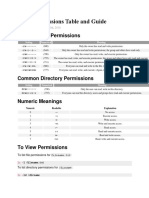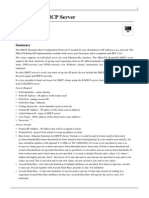0 ratings0% found this document useful (0 votes) 10 views11 pagesUser Management in Linux
Copyright
© © All Rights Reserved
We take content rights seriously. If you suspect this is your content,
claim it here.
Available Formats
Download as PDF or read online on Scribd
Learn User Management in Linux
RHEL A Comprehensive Guide
If you Interested DevOps & AWS and Linux & Bash
Hands-On Materials and Notes, Direct Message to me
for Price Details.
Table Of Contents
1, What isa User in Linux?
© Understanding sudo in User Management
2. User Management Commands in Linux
© Howto Adda User
© How to Check ifa User is Created
© Howto Assign a Password
© How to Switch Users
Understanding Groups in Linux
© How to Modify Users
3. Final Words�What is a User in Linux?
Auser in Linux is an account that allows someone (or a process) to
interact with the system. Since Linux is a multi-user operating system,
multiple users can exist on the same system, each with their own
settings, files, and permissions. Users can have different levels of
permissions, which determine what they can access or modify on the
system.
Linux categorizes users into three main types based on their roles and
privileges:
1. Privileged Users: These users have unrestricted access to the entire
system. They have the highest level of permissions and can perform
any operation on the system. They can install/remove software,
modify system files, create/manage users, and even delete
everything. These users are also called root users.
2. System Users: The system creates these users to run background
processes or services. They can’t login like a normal user. Their sole
purpose is to manage system operations like databases, web servers
and scheduled tasks.
3. Normal Users: These are the everyday users created by
administrators or during system installation. They have their home
directory and can store personal files and settings. They can’t
modify system files but can execute tasks within their permission
scope.
Understanding sudo in User Management
The sudo (Superuser Do) command allows a regular user to execute
administrative tasks with elevated privileges. Since user management
tasks—such as adding, modifying, or deleting users—require root access,
normal users must use sudo before these commands.
Note that the following commands are executed as the root user. If you
are using a normal user account, you must prefix them with sudo to
perform user management tasks.�Now let’s see how we manage users on RHEL.
User Management Commands in Linux
How to add a user
To create a new user account, use following command:
Syntax:
useradd [user_name]
Example:
useradd Tanishka # Root user
sudo useradd Tanishka # Normal user
Once you create a user, you can verify its existence in the etc/passwd
file. This file stores essential user account information (but not
passwords, despite the name).
How to check if a user is created
To confirm the user entry in /etc/passwd, use one of the following
methods:
1. View the file using cat or grep
2. Use id command:
The id command is used to display a user’s UID (User ID), GID (Group ID),
and the groups they belong to. It helps in verifying user information and
checking permissions.
id Tanishka
# Displays user id of Tanishka,
# hence verifying user has been created�Let’s understand what’s going on in the /etc/password fields. Each line in
/etc/passwd represents a user account and contains seven fields
separated by colons (:):
username: x:UID:GID: comment :home_directory:shell
Field Description
username Name of the user (for example, john, admin).
Placeholder for the password (actual password is stored
x s
in /etc/shadow).
UID User ID (for example, 1001 for a normal user, 0 for root).
GID Group ID (primary group of the user).
Optional user description (for example, full name or other
comment
info).
home directory || User’s home directory (for example /home/john).
shell The default shell assigned to the user (for example,
/bin/bash, /bin/sh, /usr/sbin/nologin).
How to Assign a Password
Once an account is created, it’s essential to assign a password to the
account. Otherwise, that account can’t be logged in through a GUI login
interface. To give a password to a user account, user this command:
Syntax:
passwd [user_name]
Example:
passwd Tanishka
You will be prompted to enter the password. Enter the password and
you’re all set! Even though user information is stored in /etc/passwd file,
actual information about the password is stored in the /etc/shadow file
(weird, I know...).�To see the content of the /etc/shadow file, use this command:
cat /etc/shadow
Each line in /etc/shadow represents a user account password and
contains nine fields separated by colons (:):
Field Description
username |] User’s login name
password || Encrypted password or password status (for example, locked)
lastchg Last password change (days since Jan 1, 1970)
min Minimum days between password changes
max Maximum days before password change is required
warn Warning period before password expiration
inactive _ | Inactive period after password expiration
expire Account expiration date (days since Jan 1, 1970)
reserved _ || Reserved for future use
To change password aging information, you use the chage (short for
change age) command like this:
Syntax:
chage [OPTIONS] [user_name]
Now that you have learned to create users and assign passwords, you
need to know how to switch between users. Let’s see that now.
How to Switch Users
The su (Substitute User) command allows you to switch from one user to
another without logging out of the current session.
Syntax:
su - [user_name]�Example:
su - Tanishka # Switches to Tanishka user
e su stands for "substitute user” (or "switch user").
e The - (hyphen) loads the target user's full environment, including
their shell, path, and profile settings (similar to logging in as that
user).
¢ Ifno username is provided, it switches to the root user by default.
To return to original or root user, simply enter ‘exit’.
Understanding Groups in Linux
Just like a party where guests can belong to different social circles, Linux
groups allow users to be part of different permission levels. Groups help
manage file access, system privileges, and administrative controls
efficiently.
Linux has two types of groups:
1. Primary Group:
e Every user has one primary group.
e When a user creates a new file, it belongs to their primary group.
¢ It is usually named the same as the username.
2. Secondary Groups:
« Auser can belong to multiple secondary groups.
e These groups provide additional permissions beyond the primary
group.
e Users can be assigned to various secondary groups to access shared
resources.�To check a user’s group membership:
id [user_name]
This displays the user’s UID, primary group GID), and any secondary
groups they belong to.
To add a new group:
groupadd [group_name]
How to Modify a User
Sometimes, you might need to update user details, such as changing
usernames, user IDs, group memberships, home directories, or login
shells. You use the usermod command to modify existing user accounts
while preserving their files and configurations.
Syntax:
usermod [OPTIONS] [user_name]
Let’s break down the different options available for modifying user
accounts.
1. Change the username
If you want to rename an existing user, use the - 1 option:
Syntax:
usermod -1l new_username old_username
Example:
usermod -l tanishkamakode tanishka�This renames tanishka to tanishkamakode. Just keep in mind that the
home directory remains the same (/home/tanishka), so you might need
to rename it manually.
To rename the home directory as well, use:
mv /home/tanishka /home/tanishkamakode
2. Change the user id:
Each user has a unique User ID (UID). If you need to change it, use -u.
Syntax:
usermod -u new_UID user_name
Example:
usermod -u 2001 tanishka
This changes tanishka's UID to 2001. Before you do this, you'll want to
make sure that no other user has the same UID. This is important.
If the user owns files under the old UID, you should update them after
changing the UID.
3. Change the primary group
Every user belongs to a primary group. To change it, use -g.
Syntax:
usermod -g new_group user_name
Example:
usermod -g developers tanishka�This changes tanishka's primary group to deve Lopers. Just keep in
mind that usermod -g developers tanishka removes the user from
all secondary groups. To avoid that, just make sure you check and re-add
secondary groups as needed.
Also, the group must exist beforehand. To create a group, run this
command:
Syntax:
groupadd [group_name]
Example:
groupadd developers
Now, to check tanishka’s group, do the following:
id tanishka
4. Add to a secondary group
Auser can belong to multiple secondary groups. Use -G to assign them.
Syntax:
usermod -G group1,group2 user_name
Example:
usermod -G linux,docker tanishka
This adds tanishka to the sudo and docker groups. Just keep in mind
that this replaces any existing secondary groups that the user might
already belong to. To add groups without removing the current ones, use
-aG (append to groups) like this:�usermod -aG linux,docker tanishka
5. Change the home directory:
You can change a user’s default home directory using -d.
Syntax:
usermod -d /new/home_directory user_name
Example:
usermod -d /home/tani tanishka
This sets tanishka’s home directory to /home/tani, but it does not
move existing files. To move them, add the -m option:
usermod -d /home/tani -m tanishka
After moving the home directory, just make sure you’ve updated file
ownership.
6. Change the login shell:
The default shell for a user can be changed using -s.
Syntax:
usermod -s /new/shell user_name
Example:
usermod -s /bin/zsh tanishka
This changes tanishka's default shell to zsh. Common shells include:
e /bin/bash (default)�e /bin/sh
e /bin/zsh
e /usr/sbin/nologin (to disable login)
With usermod, you can fine-tune user settings to match system
requirements. Always check changes using:
id tanishka
grep tanishka /etc/passwd





























































